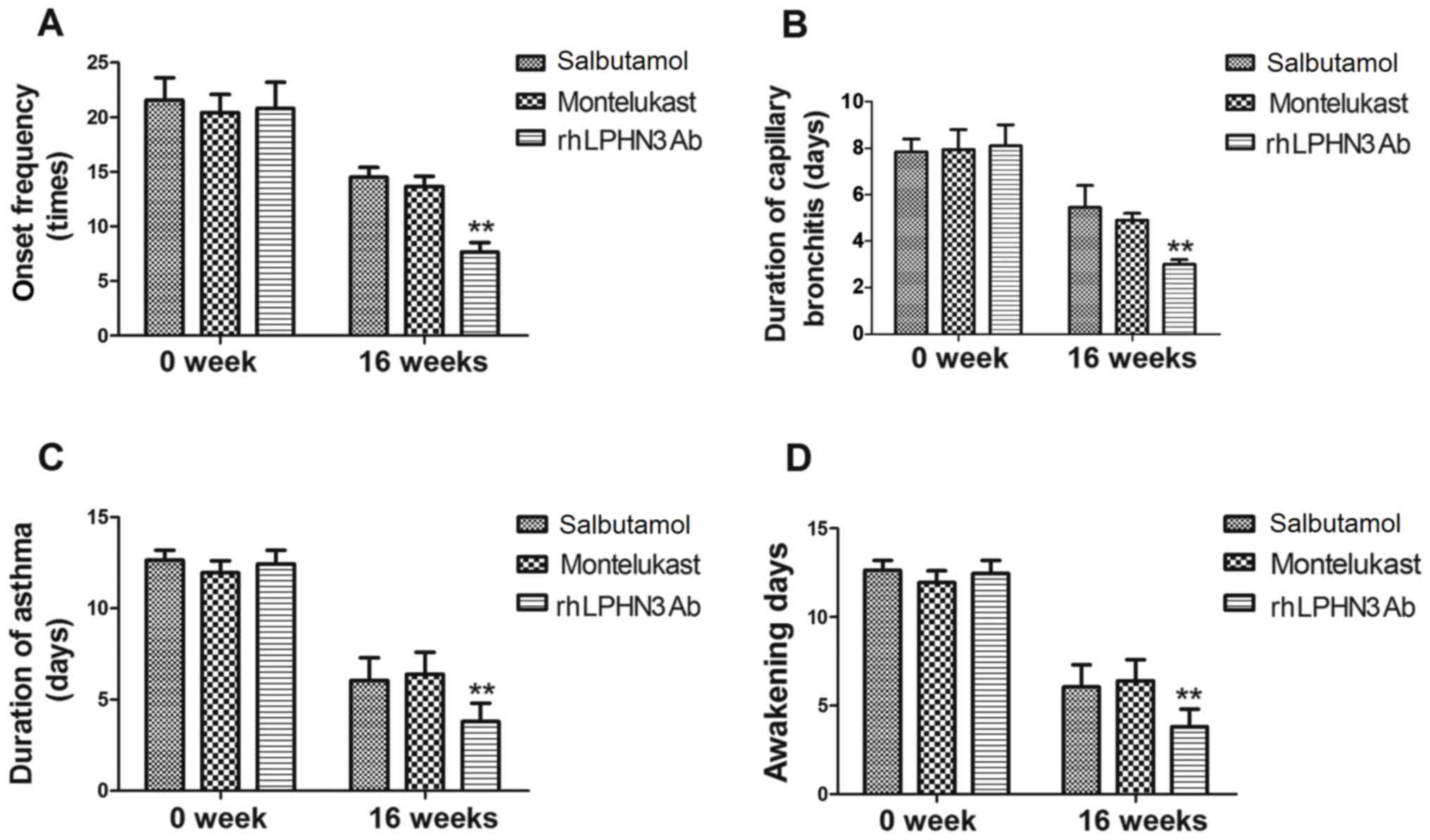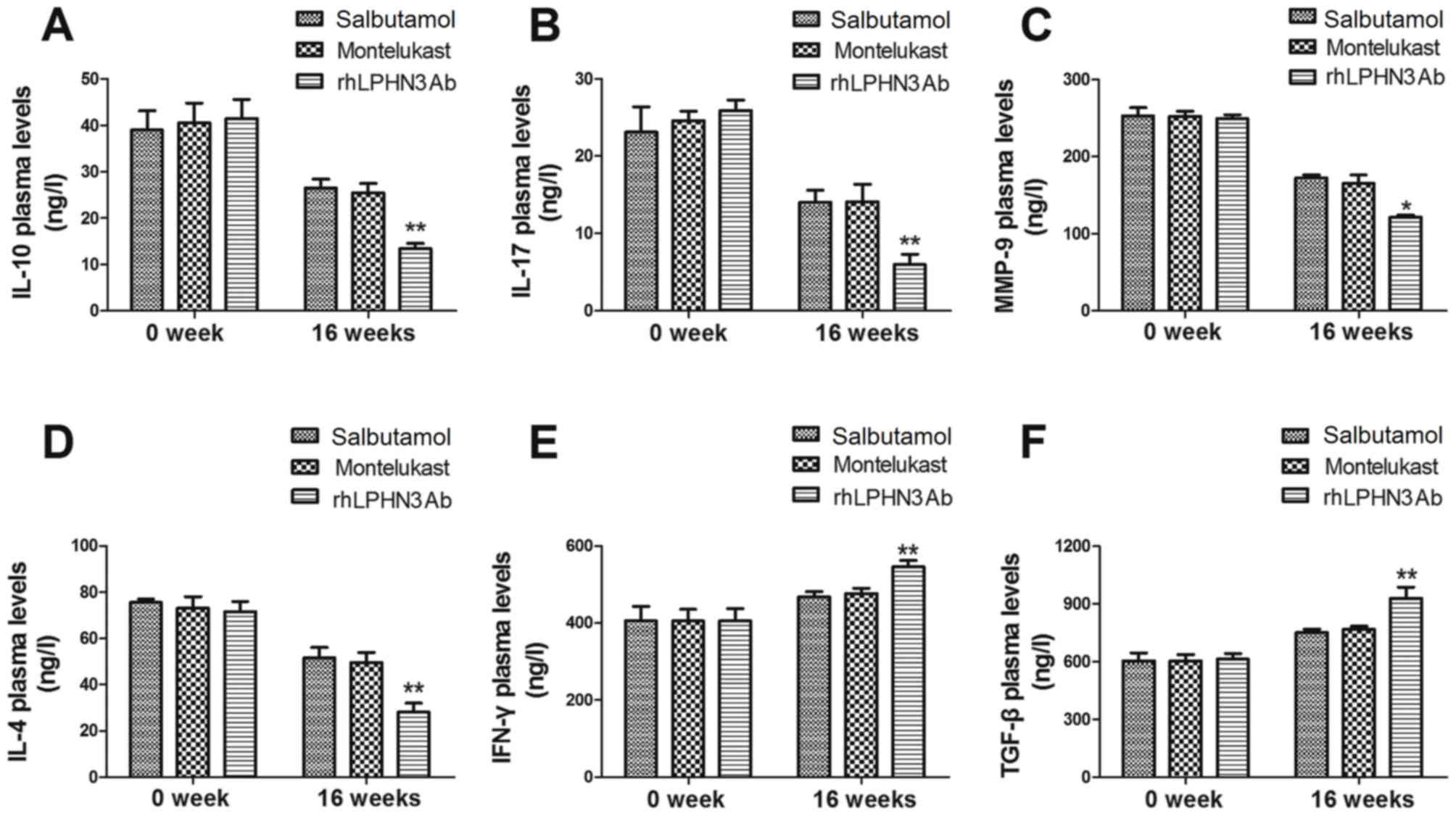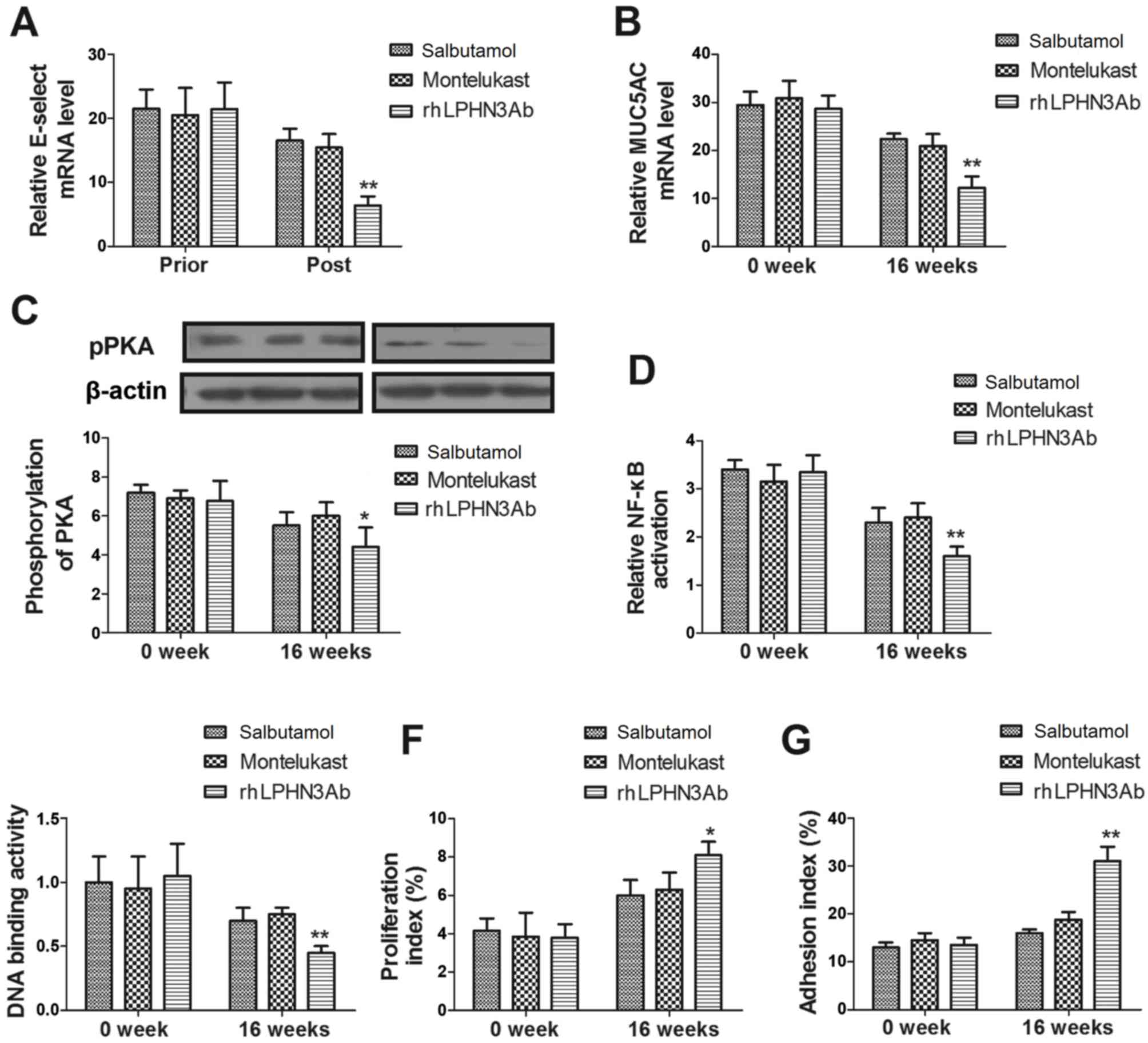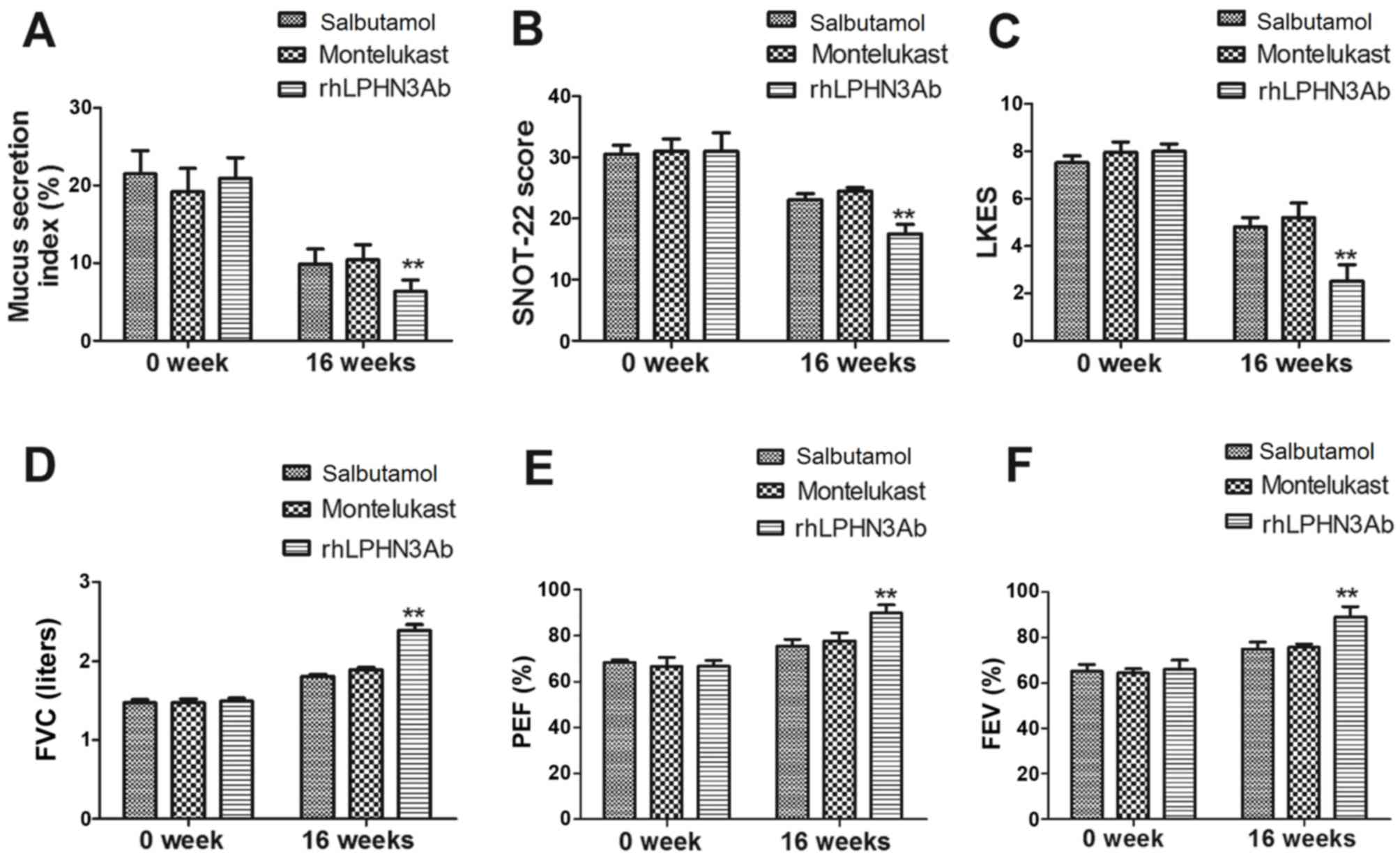|
1
|
Rubin BK: Asthma 2015: The year in review.
Respir Care. 61:556–559. 2016. View Article : Google Scholar : PubMed/NCBI
|
|
2
|
Rodriguez-Villamizar LA, Berney C,
Villa-Roel C, Ospina MB, Osornio-Vargas A and Rowe BH: The role of
socioeconomic position as an effect-modifier of the association
between outdoor air pollution and children's asthma exacerbations:
An equity-focused systematic review. Rev Environ Health.
31:297–309. 2016. View Article : Google Scholar : PubMed/NCBI
|
|
3
|
Rodrigo GJ and Plaza V: Once-daily
fluticasone furoate and vilanterol for adolescents and adults with
symptomatic asthma: A systematic review with meta-analysis. Ann
Allergy Asthma Immunol. 116:565–570. 2016. View Article : Google Scholar : PubMed/NCBI
|
|
4
|
Pols DH, Wartna JB, Moed H, van Alphen EI,
Bohnen AM and Bindels PJ: Atopic dermatitis, asthma and allergic
rhinitis in general practice and the open population: A systematic
Review. Scand J Prim Health Care. 34:143–150. 2016. View Article : Google Scholar : PubMed/NCBI
|
|
5
|
Paone G, Leone V, Conti V, De Marchis L,
Ialleni E, Graziani C, Salducci M, Ramaccia M and Munafò G: Blood
and sputum biomarkers in COPD and asthma: A review. European Rev
Med Pharmacol Sci. 20:698–708. 2016.
|
|
6
|
Nwaru BI, McCleary N, Erkkola M, Kaila M,
Virtanen SM and Sheikh A: Assisted reproductive technology and risk
of asthma and allergy in the offspring: Protocol for a systematic
review and meta-analysis. BMJ Open. 6:e0106972016. View Article : Google Scholar : PubMed/NCBI
|
|
7
|
Oh S, Ji H, Barzman D, Lin PI and Hutton
J: Pediatric asthma and autism-genomic perspectives. Clin Transl
Med. 4:372015. View Article : Google Scholar : PubMed/NCBI
|
|
8
|
Wu DJ, Hipolito E, Bilderback A, Okelo SO
and Garro A: Predicting future emergency department visits and
hospitalizations for asthma using the pediatric asthma control and
communication instrument-emergency department version (PACCI-ED). J
Asthma. 53:387–391. 2016. View Article : Google Scholar : PubMed/NCBI
|
|
9
|
Doymaz S, Schneider J and Sagy M: Early
administration of terbutaline in severe pediatric asthma may reduce
incidence of acute respiratory failure. Ann Allergy Asthma Immunol.
112:207–210. 2014. View Article : Google Scholar : PubMed/NCBI
|
|
10
|
Myers TR: Pediatric asthma epidemiology:
Incidence, morbidity, and mortality. Respir Care Clin N Am. 6:1–14.
2000. View Article : Google Scholar : PubMed/NCBI
|
|
11
|
Doymaz S and Schneider J: Safety of
terbutaline for treatment of acute severe pediatric asthma. Pediatr
Emerg Care. Mar 8–2016.(Epub ahead of print). View Article : Google Scholar : PubMed/NCBI
|
|
12
|
Booster GD, Oland AA and Bender BG:
Psychosocial factors in severe pediatric asthma. Immunol Allergy
Clin North Am. 36:449–460. 2016. View Article : Google Scholar : PubMed/NCBI
|
|
13
|
Idris IB, Ghazi HF, Zhie KH, Khairuman KA,
Yahya SK, Abd Zaim FA, Nam CW, Rasid HZ Abdul and Isa ZM:
Environmental air pollutants as risk factors for asthma among
children seen in pediatric clinics in UKMMC, Kualalumpur. Annals
Glob Health. 82:202–208. 2016. View Article : Google Scholar
|
|
14
|
Faiz A, Donovan C, Nieuwenhuis MA, van den
Berge M, Postma DS, Yao S, Park CY, Hirsch R, Fredberg JJ, Tjin G,
et al: Latrophilin receptors: Novel bronchodilator targets in
asthma. Thorax. 72:84–82. 2017. View Article : Google Scholar
|
|
15
|
Volynski KE, Silva JP, Lelianova VG,
Rahman M Atiqur, Hopkins C and Ushkaryov YA: Latrophilin fragments
behave as independent proteins that associate and signal on binding
of LTX(N4C). EMBO J. 23:4423–4433. 2004. View Article : Google Scholar : PubMed/NCBI
|
|
16
|
Gao GX, Li QM and Shen HH: Effect of
astragali-cordyceps mixtura on TGF-beta/Smad signal pathway in the
lung of asthma airway remodeling. J Ethnopharmacol. 125:68–74.
2009. View Article : Google Scholar : PubMed/NCBI
|
|
17
|
Li CC, Lin L, Wang XL, Guan XJ, Su MS,
Xiang QW, Han H, Zhang WX and Li MR: Role of c-Jun N-terminal
kinase signal transduction pathway in the course of airway
remodeling of asthma rat. Zhonghua er ke za zhi. Zhonghua Er Ke Za
Zhi. 46:535–539. 2008.(In Chinese).
|
|
18
|
Xie M, Liu XS, Xu YJ, Zhang ZX, Bai J, Ni
W and Chen SX: Role of the extracellular signal-regulated kinase
1/2 signaling pathway in regulating the secretion of bronchial
smooth muscle cells in a rat model of chronic asthma. Chin Med J
(Engl). 121:73–77. 2008.PubMed/NCBI
|
|
19
|
Caminha GP, Junior JT Melo, Hopkins C,
Pizzichini E and Pizzichini MM: SNOT-22: Psychometric properties
and cross-cultural adaptation into the Portuguese language spoken
in Brazil. Braz J Otorhinolaryngol. 78:34–39. 2012. View Article : Google Scholar : PubMed/NCBI
|
|
20
|
Livak KJ and Schmittgen TD: Analysis of
relative gene expression data using real-time quantitative PCR and
the 2(-Delta Delta C(T)) methods. Methods. 25:402–408. 2001.
View Article : Google Scholar : PubMed/NCBI
|
|
21
|
Janockova J, Zilecka E, Kasparkova J,
Brabec V, Soukup O, Kuca K and Kozurkova M: Assessment of
DNA-binding affinity of cholinesterase reactivators and
electrophoretic determination of their effect on topoisomerase I
and II activity. Mol Biosyst. 12:2910–2920. 2016. View Article : Google Scholar : PubMed/NCBI
|
|
22
|
Rudmik L, Soler ZM, Mace JC, DeConde AS,
Schlosser RJ and Smith TL: Using preoperative SNOT-22 score to
inform patient decision for Endoscopic sinus surgery. Laryngoscope.
125:1517–1522. 2015. View Article : Google Scholar : PubMed/NCBI
|
|
23
|
Huang J, Chen Y, Long Z, Zhou X and Shu J:
Clinical efficacy of tiotropium in children with asthma. Pak J Med
Sci. 32:462–465. 2016.PubMed/NCBI
|
|
24
|
Diaz I and Mateu E: Use of ELISPOT and
ELISA to evaluate IFN-gamma, IL-10 and IL-4 responses in
conventional pigs. Vet Immunol Immunopathol. 106:107–112. 2005.
View Article : Google Scholar : PubMed/NCBI
|
|
25
|
Mehravi B, Alizadeh AM, Khodayari S,
Khodayari H, Ashtari K, Mohseni M, Anaraki NI, Dana EA, Safari S
and Amanlou M: Acute toxicity evaluation of glycosylated Gd3+-based
silica nanoprobe. Mol Imaging Biol. 19:522–530. 2017. View Article : Google Scholar : PubMed/NCBI
|
|
26
|
Kim SP, Lee SJ, Nam SH and Friedman M: Elm
Tree (Ulmus parvifolia) Bark Bioprocessed with Mycelia of Shiitake
(Lentinus edodes) Mushrooms in Liquid Culture: Composition and
mechanism of protection against allergic asthma in mice. J Agric
Food Chem. 64:773–784. 2016. View Article : Google Scholar : PubMed/NCBI
|
|
27
|
Bardin P, Kanniess F, Gauvreau G,
Bredenbroker D and Rabe KF: Roflumilast for asthma: Efficacy
findings in mechanism of action studies. Pulm Pharmacol Ther. 35
Suppl:S4–S10. 2015. View Article : Google Scholar : PubMed/NCBI
|
|
28
|
Johnathan M, Gan SH, Ezumi MF, Faezahtul
AH and Nurul AA: Phytochemical profiles and inhibitory effects of
Tiger Milk mushroom (Lignosus rhinocerus) extract on
ovalbumin-induced airway inflammation in a rodent model of asthma.
BMC Complement Altern Med. 16:1672016. View Article : Google Scholar : PubMed/NCBI
|
|
29
|
de Araujo CC, Marques PS, Silva JD, Samary
CS, da Silva AL, Henriques I, Antunes MA, de Oliveira MV,
Goldenberg RC, Morales MM, et al: Regular and moderate aerobic
training before allergic asthma induction reduces lung inflammation
and remodeling. Scand J Med Sci Sports. 26:1360–1372. 2016.
View Article : Google Scholar : PubMed/NCBI
|
|
30
|
Phillips JE, Renteria L, Burns L, Harris
P, Peng R, Bauer CM, Laine D and Stevenson CS: Btk inhibitor RN983
delivered by dry powder nose-only aerosol inhalation inhibits
bronchoconstriction and pulmonary inflammation in the ovalbumin
allergic mouse model of asthma. J Aerosol Med Pulm Drug Deliv.
29:233–241. 2016. View Article : Google Scholar : PubMed/NCBI
|
|
31
|
Li Z, Zheng J, Zhang N and Li C: Berberine
improves airway inflammation and inhibits NF-κB signaling pathway
in an ovalbumin-induced rat model of asthma. J Asthma. 53:999–1005.
2016. View Article : Google Scholar : PubMed/NCBI
|
|
32
|
Choudhry Z, Sengupta SM, Grizenko N,
Fortier ME, Thakur GA, Bellingham J and Joober R: LPHN3 and
attention-deficit/hyperactivity disorder: Interaction with maternal
stress during pregnancy. J Child Psychol Psychiatry. 53:892–902.
2012. View Article : Google Scholar : PubMed/NCBI
|
|
33
|
Tobaben S, Sudhof TC and Stahl B: Genetic
analysis of alpha-latrotoxin receptors reveals functional
interdependence of CIRL/latrophilin 1 and neurexin 1 alpha. J Biol
Chem. 277:6359–6365. 2002. View Article : Google Scholar : PubMed/NCBI
|
|
34
|
Vanders RL, Gibson PG, Wark PA and Murphy
VE: Alterations in inflammatory, antiviral and regulatory cytokine
responses in peripheral blood mononuclear cells from pregnant women
with asthma. Respirology. 18:827–833. 2013. View Article : Google Scholar : PubMed/NCBI
|
|
35
|
Mauffray M, Domingues O, Hentges F, Zimmer
J, Hanau D and Michel T: Neurturin influences inflammatory
responses and airway remodeling in different mouse asthma models. J
Immunol. 194:1423–1433. 2015. View Article : Google Scholar : PubMed/NCBI
|
|
36
|
Vanoirbeek JA, De Vooght V, Nemery B and
Hoet PH: Multiple challenges in a mouse model of chemical-induced
asthma lead to tolerance: Ventilatory and inflammatory responses
are blunted, immunologic humoral responses are not. Toxicology.
257:144–152. 2009. View Article : Google Scholar : PubMed/NCBI
|
|
37
|
Lim Y, Vasu VT, Valacchi G, Leonard S,
Aung HH, Schock BC, Kenyon NJ, Li CS, Traber MG and Cross CE:
Severe vitamin E deficiency modulates airway allergic inflammatory
responses in the murine asthma model. Free Radical Res. 42:387–396.
2008. View Article : Google Scholar
|
|
38
|
Bhandari V, Choo-Wing R, Chapoval SP, Lee
CG, Tang C, Kim YK, Ma B, Baluk P, Lin MI and McDonald DM:
Essential role of nitric oxide in VEGF-induced, asthma-like
angiogenic, inflammatory, mucus, and physiologic responses in the
lung. Proc Natl Acad Sci USA. 103:pp. 11021–11026. 2006; View Article : Google Scholar : PubMed/NCBI
|
|
39
|
Gaga M, Zervas E and Loukides S: The
usefulness of inflammatory markers in monitoring treatment
responses in asthma. Clin Exp Allergy. 33:855–858. 2003. View Article : Google Scholar : PubMed/NCBI
|
|
40
|
Boulay ME and Boulet LP: Lower airway
inflammatory responses to repeated very-low-dose allergen challenge
in allergic rhinitis and asthma. Clin Exp Allergy. 32:1441–1447.
2002. View Article : Google Scholar : PubMed/NCBI
|
|
41
|
Foster PS, Ming Y, Matthei KI, Young IG,
Temelkovski J and Kumar RK: Dissociation of inflammatory and
epithelial responses in a murine model of chronic asthma. Lab
Invest. 80:655–662. 2000. View Article : Google Scholar : PubMed/NCBI
|
|
42
|
Provotorov VM, Budnevsky AV and Filatova
YI: Clinical manifestations of asthma during combination therapy
using ceruloplasmin. Ter Arkh. 88:36–39. 2016.(In Russian).
View Article : Google Scholar : PubMed/NCBI
|
|
43
|
Hartmann K, Escribano L, Grattan C,
Brockow K, Carter MC, Alvarez-Twose I, Matito A, Broesby-Olsen S,
Siebenhaar F, Lange M, et al: Cutaneous manifestations in patients
with mastocytosis: Consensus report of the European Competence
Network on Mastocytosis; the American Academy of Allergy, Asthma
& Immunology; and the European Academy of Allergology and
Clinical Immunology. J Allergy Clin Immunol. 137:35–45. 2016.
View Article : Google Scholar : PubMed/NCBI
|
|
44
|
Ghaffari J, Hossiani R Farid, Khalilian A,
Nahanmoghadam N, Salehifar E and Rafatpanah H: Vitamin e
supplementation, lung functions and clinical manifestations in
children with moderate asthma: A randomized double blind
placebo-controlled trial. Iran J Allergy Asthma Immunol. 13:98–103.
2014.PubMed/NCBI
|
|
45
|
García-Martín E, García-Menaya J, Sánchez
B, Martínez C, Rosendo R and Agúndez JA: Polymorphisms of
histamine-metabolizing enzymes and clinical manifestations of
asthma and allergic rhinitis. Clin Exp Allergy. 37:1175–1182. 2007.
View Article : Google Scholar : PubMed/NCBI
|
|
46
|
Kim TB, Kim YK, Chang YS, Kim SH, Hong SC,
Jee YK, Cho SH, Min KU and Kim YY: Association between
sensitization to outdoor spider mites and clinical manifestations
of asthma and rhinitis in the general population of adults. J
Korean Med Sci. 21:247–252. 2006. View Article : Google Scholar : PubMed/NCBI
|
|
47
|
Araujo MI and de Carvalho EM: Human
schistosomiasis decreases immune responses to allergens and
clinical manifestations of asthma. Chem Immunol Allergy. 90:29–44.
2006.PubMed/NCBI
|
|
48
|
Khamidova ZN: Clinical manifestations and
a course of bronchial asthma complicated by gastroduodenal
pathology. Probl Tuberk. 44–45. 2002.(In Russian). PubMed/NCBI
|
|
49
|
Zhou Y, Wang GF, Yang L, Liu F, Kang JQ,
Wang RL, Gu W and Wang CY: Treatment with 1,25(OH)2D3 induced HDAC2
expression and reduced NF-κB p65 expression in a rat model of
OVA-induced asthma. Braz J Med Biol Res. 48:654–664. 2015.
View Article : Google Scholar : PubMed/NCBI
|
|
50
|
Pan C and Dong Z: Antiasthmatic Effects of
Eugenol in a Mouse Model of Allergic Asthma by Regulation of
Vitamin D3 Upregulated Protein 1/NF-κB Pathway. Inflammation.
38:1385–1393. 2015. View Article : Google Scholar : PubMed/NCBI
|
|
51
|
Garcia-Garcia FJ, Mullol J, Perez-Gonzalez
M, Pujols L, Alobid I, Roca-Ferrer J and Picado C: Signal
transduction pathways (MAPKs, NF-κB, and C/EBP) regulating COX-2
expression in nasal fibroblasts from asthma patients with aspirin
intolerance. PLoS One. 7:e512812012. View Article : Google Scholar : PubMed/NCBI
|
|
52
|
Shimizu K, Konno S, Ozaki M, Umezawa K,
Yamashita K, Todo S and Nishimura M: Dehydroxymethylepoxyquinomicin
(DHMEQ), a novel NF-kappaB inhibitor, inhibits allergic
inflammation and airway remodelling in murine models of asthma.
Clin Exp Allergy. 42:1273–1281. 2012. View Article : Google Scholar : PubMed/NCBI
|
|
53
|
Lim JC, Goh FY, Sagineedu SR, Yong AC,
Sidik SM, Lajis NH, Wong WS and Stanslas J: A semisynthetic
diterpenoid lactone inhibits NF-κB signalling to ameliorate
inflammation and airway hyperresponsiveness in a mouse asthma
model. Toxicol Appl Pharmacol. 302:10–22. 2016. View Article : Google Scholar : PubMed/NCBI
|


















